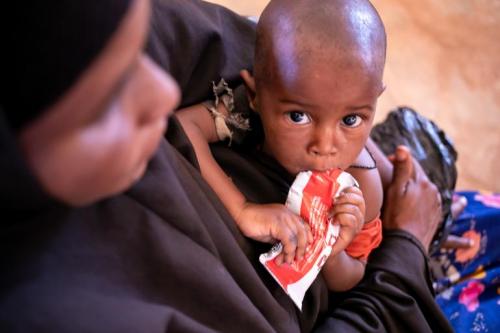At least 10 million children face severe drought in the Horn of Africa – UNICEF
UN Children’s Fund warns of rapid rise in need as humanitarian funding requirements double
The number of children facing severe drought conditions across the Horn of Africa has increased by more than 40 per cent in the space of two months, warns UNICEF. Between February and April, the number of children facing the impact of drought including acute hunger, malnutrition and thirst increased from 7.25 million to at least 10 million.

On 3 February 2022 in Somalia, a child feeds on a Ready-to-Use Therapeutic Food (RUTF) packet while his mother holds him waiting to receive assistance at Community Empowerment and Development Action Health Centre in Dolow.
UNICEF has revised its emergency appeal from $119 million to nearly $250 million to reflect the growing need across the region. Only 20 per cent is funded.
More than 1.7 million children across Ethiopia, Kenya and Somalia require urgent treatment for severe acute malnutrition. If rains fail in the coming weeks, this figure will rise to 2 million.
“If we don’t act now we will see an avalanche of child deaths in a matter of weeks,” says Mohamed M. Fall, UNICEF Regional Director for Eastern and Southern Africa. “Famine is just around the corner.”
The climate-induced emergency across the Horn of Africa is the worst drought the region has seen in 40 years. Three consecutive dry seasons have driven hundreds of thousands of people from their homes, killed vast swathes of livestock and crops, fuelled malnutrition and increased the risk of disease. In Somalia more than 81,000 people are at risk of famine by the end of June if a fourth consecutive rainy season fails, food prices continue to rise sharply, and humanitarian assistance is not stepped up.
Within the past two months across the Horn of Africa:
● The number of households without reliable access to clean and safe water has almost doubled – from 5.6 million to 10.5 million.
● The number of people classified as food insecure has risen from 9 million to 16 million.
● The number of children out of school has remained disturbingly high at 15 million. An additional 1.1 million children are at risk of dropping out with thousands of schools already lacking access to water.
UNICEF is working across the region to provide life-saving aid, including treatment for severe acute malnutrition and access to clean water and health services. Along with partners, UNICEF is providing lifelines to families such as cash transfers, to keep children in education and to protect them from abuse and exploitation.
“We need to act now to save children’s lives – but also to protect childhoods,” says Mohamed M Fall. “Children are losing their homes, their education and their right to grow up safe from harm. They deserve the world’s attention now.”
Source: United Nations International Children's Education Fund
- 164 reads
Human Rights
Ringing FOWPAL’s Peace Bell for the World:Nobel Peace Prize Laureates’ Visions and Actions

Protecting the World’s Cultural Diversity for a Sustainable Future

The Peace Bell Resonates at the 27th Eurasian Economic Summit

Declaration of World Day of the Power of Hope Endorsed by People in 158 Nations

Puppet Show I International Friendship Day 2020

